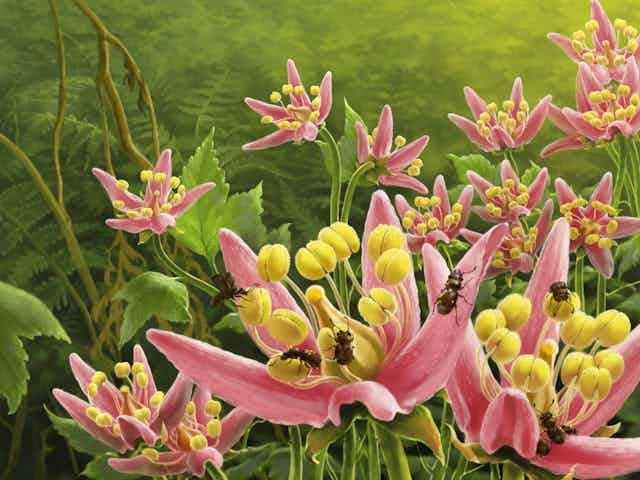The world as we know it today is almost inconceivable without the rich and colourful landscapes created by plant life. Among them are flowering plants, or angiosperms, which are by far the most diverse and abundant group of plants, making up over 80% of all known species, including all our staple food crops.
But the world was not always like this. There was a time when plant life was almost exclusively green. Then, in the time of the dinosaurs, the world burst magnificently into bloom.
Flowers blessed our environment with chromatic vibrancy, but they also upturned food chains and elbowed out their nonflowering predecessors. Little is known about how ecosystems reacted to this sudden blossoming. But now, a tiny beetle, preserved in amber for 99 million years, has provided a valuable clue about how insects first began nourishing themselves on a colourful new platter of plants.
First flowers
While there are debates about when exactly angiosperms originated, there is little quarrel that they first became diverse in the Early Cretaceous, around 125 million years ago.
It is believed that the explosive radiation of angiosperms that displaced the gymnosperms – the incumbent, flowerless champions of the plant world – caused unprecedented upheaval in terrestrial ecosystems, changing the food chain at all levels from the herbivores to their predators.
The largest remaining group of gymnosperms are the conifers, such as pines and cypresses. Many gymnosperms are pollinated by wind, although some produce sugar-containing pollination drops, such as fern-like cycads, which maintain an ancient relationship with beetles. Flowering angiosperms quickly outcompeted most gymnosperms with their colourful and scented galleries, which advertised their nectar to attract pollinators.
Yet we know very little about the life of the earliest angiosperms. Most Cretaceous flowers have been recovered from burnt remains converted to charcoal, making reconstructions of how they looked a rare and difficult task. Scientists have also studied living angiosperms to try to reconstruct what the world’s first flower might have looked like.
Read more: Revealed: the first ever flower, 140m years ago, looked like a magnolia
The pollinators of these early flowers have remained shrouded in a further layer of mystery. Today, over 80% of angiosperms depend on insects, such as bees and day-flying butterflies, to pollinate them. But these groups were either not present or not diverse in the Cretaceous. So who were the earliest pollinators of angiosperms?
Jurassic pollinators
Many insects had mutualistic associations with plants before the Cretaceous. Some Jurassic scorpionflies possessed elongated mouth parts ideally suited for pollinating gymnosperms. And fortuitous fossils from Early Cretaceous amber in Spain have also revealed thrips – small, slender insects – associated with the pollen of gymnosperms.

But what of the relationship between the earliest angiosperms and their insect pollinators? In palaeontology, exceptional questions call for exceptional fossils, and it’s amber that often provides them. Amber is the resin of ancient trees that fossilised over millions of years and preserved its content with life-like fidelity.
Bits of insects and plants trapped inside provide an unparalleled window into ancient ecosystems. Scientists have amassed a unique collection of over 20,000 amber pieces from northern Myanmar, found in 2016. This amber dates to around 99 million years ago, during the golden age of angiosperm diversification, and preserves diverse insects, plants and even occasional dinosaur remains.
Read more: Ancient lizard found preserved in 99-million-year-old amber
As palaeontologists working with amber, we have to sort out individual pieces, identify their content, and carefully carve them down to give a clear view of the fossil inside, sometimes down to the thickness of a microscope slide. In this Jurassic Park-like adventure, work has to be done slowly, with surgical precision.
Laborious work on the amber soon started to bear fruits. In late 2019, the amber from northern Myanmar yielded a tumbling flower beetle (Mordellidae) with numerous angiosperm pollen grains attached to its body. This was followed by the discovery of short-winged flower beetles associated with eudicot pollen similar to that produced by water lilies – an early diverging group of angiosperms. Further discoveries included an ancient wasp, also associated with angiosperm pollen.
Last supper
Our study focused on a short-winged flower beetle, or Pelretes vivificus, as the new fossil was named. It’s just over one millimetre in length: a lone speck in the clear orange amber.
But when we looked closer, we discovered that the beetle is associated with clusters of pollen grains: some attached directly to its body, others preserved in fossilised faecal pellets (coprolites). The coprolites are evidence of the beetle’s last meal, providing a unique line of evidence that demonstrates that the beetles indeed fed on pollen and that the two were not just preserved together by chance.

To identify the pollen, we used a selection of high-tech microscopes. The pollen turned out to be the fossil genus Tricolpopollenites. This group is attributed to the eudicots – a living group of angiosperms that includes willows, violets and coca plants. This makes Pelretes one of the earliest pollinators of angiosperms in the fossil record – and the earliest beetle with direct evidence of pollen feeding.
This tiny beetle has shown that soon after their rise to prominence, some of the earliest flowering plants already had their pollen feasted upon by insects. We now know that the association between flower beetles and angiosperms is truly ancient: unbroken for at least 99 million years when the world was erupting with colourful flowers.

